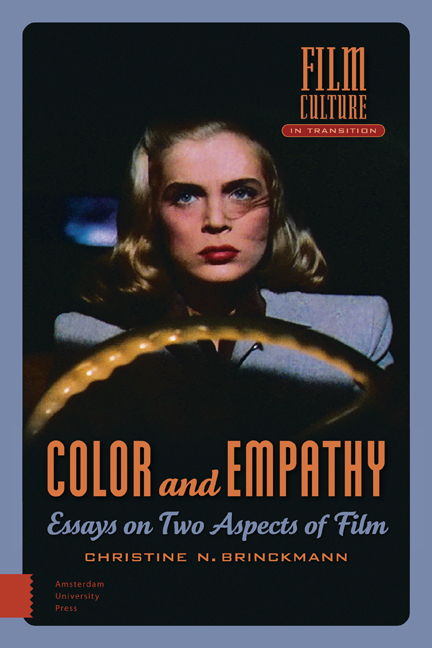Book contents
- Frontmatter
- Contents
- Preface
- Dedication
- Cinematic Color as Likeness and as Artifact: [2001]
- Chords of Color: [2006]
- The Tension of Colors in Colorized Silent Films: [2001]
- Structural Film, Structuring Color: Jenny Okun's Still Life: [1995]
- Desert Fury: A Film Noir in Color: [2012]
- The Work of the Camera: BEAU TRAVAIL: [2005]
- Empathy with the Animal: [1997]
- Motor Mimicry in Hitchcock: [1999]
- Abstraction and Empathy in the Early German Avant-garde: [1997]
- The Role of Empathy in Documentary Film: A Case Study: [2005]
- Genre Conflict in Tracey Emin’s Top Spot: [2007]
- Viewer Empathy and Mosaic Structure in Frederick Wiseman’s PRIMATE: [2009]
- CASTA DIVA: An Empathetic Reading: [2008]
- Publication Data
- Index of Films
- Index of Subjects
- Film Culture in Transition
Chords of Color: [2006]
Published online by Cambridge University Press: 23 June 2021
- Frontmatter
- Contents
- Preface
- Dedication
- Cinematic Color as Likeness and as Artifact: [2001]
- Chords of Color: [2006]
- The Tension of Colors in Colorized Silent Films: [2001]
- Structural Film, Structuring Color: Jenny Okun's Still Life: [1995]
- Desert Fury: A Film Noir in Color: [2012]
- The Work of the Camera: BEAU TRAVAIL: [2005]
- Empathy with the Animal: [1997]
- Motor Mimicry in Hitchcock: [1999]
- Abstraction and Empathy in the Early German Avant-garde: [1997]
- The Role of Empathy in Documentary Film: A Case Study: [2005]
- Genre Conflict in Tracey Emin’s Top Spot: [2007]
- Viewer Empathy and Mosaic Structure in Frederick Wiseman’s PRIMATE: [2009]
- CASTA DIVA: An Empathetic Reading: [2008]
- Publication Data
- Index of Films
- Index of Subjects
- Film Culture in Transition
Summary
It is not without reason that we speak of color tones and color compositions in art, and of tone color and chromatic scales in music. Analogies and metaphors run in both directions, art borrowing terms from music, and music terms from art in order to label phenomena that otherwise have no name.
When talking about the orchestration of color, we imagine that the colors adopt roles not unlike those of musical instruments in a concerto: they can establish relationships of tension or harmonic vicinities, can reinforce or disturb one another, take over from one another in terms of dominance, play a solo or a duet, or merely function as accompaniment. Thus we can imagine a kind of score, according to which certain colors sound simultaneously or in sequence, are loud or quiet in terms of their degree of saturation, and lavish or sparse in their application depending on their extent on the plane of color. Certain notes can come together in constellations of three or four to form color chords, appearing together for a while and acting out a relationship.
In general, the analogy to music is rather flowery and approximate rather than exact and revealing, but it is by no means futile. Above all, it can illustrate how color in film occasionally becomes autonomous in order to perform a concerto of its own kind.
What follows is intended as a contribution to a historical poetics of the color film. Using examples from a corpus that is rarely regarded as a unified group in film studies (indeed, seldom regarded at all) – namely, light entertainment from Hollywood between 1956 and 1964 – I will attempt to work out the then prevailing style of color. It can be described as an excessive, often self-reflective, playful approach that was employed for a few years across genres in Hollywood. The style was constructed on the plateau of the “classical” principles developed through two decades of Technicolor, but at the same time it parodies and undermines them.
In the mid-1930s, with the introduction of the three-strip Technicolor process which covered all the colors of the spectrum, a discussion ensued in Hollywood over the “correct” use of color.
- Type
- Chapter
- Information
- Color and EmpathyEssays on Two Aspects of Film, pp. 33 - 60Publisher: Amsterdam University PressPrint publication year: 2014



